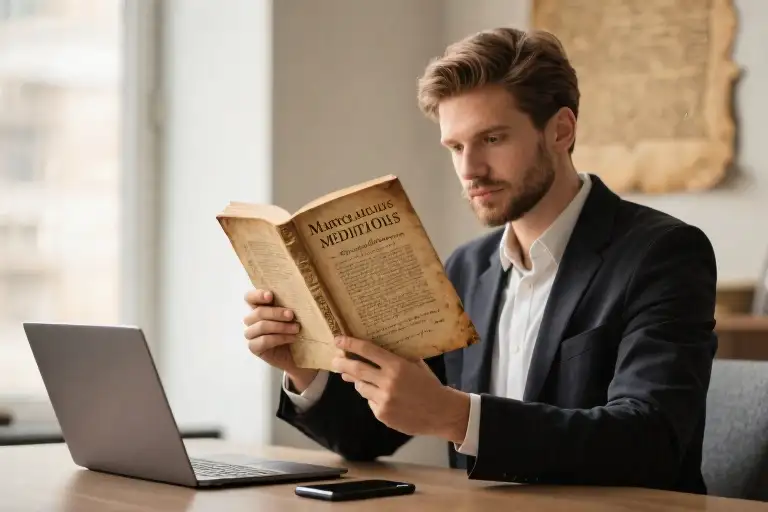The bathroom mirror fogs up as you lean closer at 1:36 AM, fingertips tracing a face that somehow feels foreign tonight. That fleeting moment when your reflection blurs into someone unrecognizable—have you met this stranger living behind your eyes?
“There’s a version of me I’ve never met,” whispers the thought you’ve been avoiding all week. That shadow self hiding in your peripheral vision when you choose safety over courage, when you mute your laughter to fit in, when you scroll past others’ highlight reels feeling like a rough draft. Modern life has turned self-recognition into a luxury—we curate personas for different audiences while our authentic selves collect dust in some forgotten inner attic.
This quiet epidemic of self-alienation manifests in subtle ways: the hollow click of liking a post you disagree with, the phantom weight of abandoned passions in your throat, the way your signature suddenly looks unfamiliar on documents. We’ve become experts at performing identities yet amateurs at being ourselves. The mirror stranger phenomenon isn’t about vanity—it’s the cognitive dissonance between who we’ve become and who we imagined we’d be.
Consider the last time you:
- Hesitated before answering “How are you?” because the truthful response felt too complex
- Felt surprised hearing your recorded voice
- Discovered an old journal entry that read like a different person’s thoughts
These aren’t glitches—they’re breadcrumbs leading to your unseen versions. Like Russian nesting dolls, we contain multitudes: the artist buried under spreadsheets, the healer masking as a cynic, the leader who forgets their own strength. That flicker of unease when you catch your reflection? It’s not dysfunction—it’s your subconscious waving a flag: “We have uncharted territory here.”
Social media didn’t create this fracture, but it widened the cracks. We now navigate a hall of funhouse mirrors—comparing our behind-the-scenes with others’ director’s cuts. The identity exploration that once unfolded gradually now happens in public view, with algorithms rewarding consistency over authenticity. No wonder we feel like strangers to ourselves when we’re constantly editing reality into bite-sized personal brands.
Yet within this disconnect lies extraordinary potential. That mirror stranger isn’t your enemy—it’s your unlived life knocking politely. When Rilke wrote “You must change your life,” he might as well have been addressing our 3 AM mirror encounters. The discomfort you feel isn’t failure—it’s your psyche’s way of saving seats for the selves you’ve yet to become.
Tonight, when you pass a shop window and pause at the unfamiliar face reflected back, try this instead of looking away: “Hello again. Tell me what I need to hear.”
The Cracks in the Mirror: Why Do We Feel Like Strangers to Ourselves?
That moment when you catch your reflection unexpectedly—maybe in a shop window or the darkened screen of your phone—and there’s this split-second delay before recognition kicks in. Who is that person staring back? For many of us, this fleeting disconnect reveals a deeper truth: we’ve become experts at curating our lives yet amateurs at knowing ourselves.
The Curated Self vs. The Hidden Self
Social media didn’t invent the gap between who we are and who we present, but it certainly widened it. Every scroll through Instagram shows us airbrushed versions of reality—including our own. We post vacation smiles but delete the arguments that happened just after the photo. We share career milestones but hide the nights spent questioning our choices. Over time, these carefully constructed highlights reels create what psychologists call the “digital self—a version that’s perpetually winning, thriving, and #livingmybestlife while our actual selves sit quietly in the shadows, accumulating unacknowledged doubts and unrealized dreams.
Consider Sarah, a 28-year-old graphic designer who appears to have it all together online. Her feed shows freelance success, yoga retreats, and artisanal coffee. What it doesn’t show: the Fulbright application she never submitted, the watercolor supplies gathering dust under her bed, or the way her hands sometimes shake when clients ask for revisions. “I’ll look at my own profile and think, ‘Who is this put-together person?'” she confesses. “The me who still cries during Pixar movies and eats cereal for dinner doesn’t make the cut.”
The Ghosts of Roads Not Taken
Those unexplored versions of ourselves often reside in the choices we didn’t make. Like Alex, who turned down a scholarship to study abroad because the thought of navigating a foreign hospital with his chronic illness felt overwhelming. Seven years later, he still dreams in fragmented French and wonders about the more adventurous self he might have discovered. “It’s not regret exactly,” he says. “More like… knowing there’s a door in my mind that stays permanently locked.”
Psychology offers a framework for this phenomenon through Carl Rogers’ concept of the “real self” (who we actually are) versus the “ideal self” (who we believe we should be). The wider this gap, research shows, the higher our levels of anxiety and dissatisfaction. But here’s the crucial nuance Rogers emphasized: the goal isn’t to erase the gap completely, but to develop what he called “unconditional positive regard” for the messy, evolving person you currently are.
When Strangers Know Us Better Than We Know Ourselves
Ironically, we often leave clues about our hidden selves in plain sight—just not where we think to look. That coworker who says “you’re surprisingly patient with difficult clients” might be seeing a strength you’ve minimized. The novel that made you sob unexpectedly could be pointing toward values you’ve neglected. Even our recurring frustrations—like always resenting people who “have it all figured out”—can signal unmet needs or untapped potentials.
This isn’t about chasing some mythical “true self” buried like treasure. As therapist and author Dr. Lisa Marchiano observes: “The parts of ourselves we’ve disowned don’t disappear. They just find sneakier ways to get our attention—through inexplicable moods, persistent daydreams, or intense reactions to certain people.” That irrational dislike of your friend’s new hobby? Might be worth exploring why it triggers you. That fictional character you can’t stop thinking about? Probably embodies qualities you’ve sidelined.
What makes this process feel so disorienting is that we’re both the archaeologist and the ruins, the detective and the mystery. But perhaps that’s the point. As poet David Whyte writes: “The only choice we have as we mature is how we inhabit our vulnerability.” The cracks in our self-perception aren’t flaws to repair—they’re openings where new light gets in.
Collecting the Pieces: Recognizing Yourself in Others and Experiences
We often search for missing parts of ourselves in the most unexpected places—sometimes in the eyes of a stranger, sometimes in the pages of a book we never thought we’d read. The journey to self-discovery isn’t about finding a pre-packaged version of who we’re “supposed” to be. It’s about collecting fragments—those fleeting moments, interactions, and even failures that reveal hidden corners of our identity we never knew existed.
Relationships as Mirrors: Seeing Yourself Through Others’ Eyes
Have you ever had a friend describe you in a way that surprised you? “You’re so much braver than you think,” or “You have this quiet wisdom about you”—comments that make you pause because they don’t quite match your self-perception. These moments are more than just compliments; they’re tiny mirrors reflecting back aspects of yourself that you’ve overlooked or undervalued.
Psychologists call this the “mirroring effect”—the phenomenon where our relationships serve as reflective surfaces helping us see dimensions of our personality that our inner critic might obscure. That coworker who points out your natural leadership during group projects? They’re showing you a piece of your puzzle. The barista who remarks on your consistent kindness every morning? That’s another fragment of your authentic self coming into focus.
Try this today: After meaningful conversations, mentally note any descriptions of you that felt unexpectedly accurate. These external observations often highlight strengths your inner dialogue ignores.
The Unexpected Gifts of Failure
When Mark lost his corporate job during company downsizing, the initial panic gave way to an unexpected sensation—relief. “It felt like being released from a role I’d outgrown but was too afraid to leave,” he shared. In the empty spaces between job applications, he began sketching again, something he hadn’t done since college. What started as stress relief gradually revealed a dormant passion for graphic design.
Failure has a way of stripping away the “shoulds” and “musts” that cloud our self-perception. That project that flopped? It showed you what truly motivates you. The relationship that ended? It clarified your non-negotiables. These experiences aren’t just setbacks; they’re signposts pointing toward versions of yourself waiting to be acknowledged.
Consider: What apparent failure actually redirected you toward a more authentic path? How did that experience reveal hidden aspects of your character or desires?
Your Daily Self-Discovery Practice
Self-awareness grows through consistent, gentle attention—not grand epiphanies. Try this simple exercise each evening:
- Recall three “This is so me” moments from your day (e.g., “Getting completely absorbed in organizing my bookshelf—that focus is totally me”)
- Note one surprising self-observation (“I didn’t realize how quickly I could lighten a tense situation until today”)
- Acknowledge one trait you’re coming to accept (“My tendency to overprepare isn’t anxiety—it’s thoroughness”)
This practice trains your mind to spot those precious fragments of self-knowledge scattered throughout ordinary days. Over time, you’ll assemble a mosaic far more interesting than any single “perfect” version of yourself could ever be.
Remember: The person you’re becoming isn’t hidden in some distant future. They’re emerging through every conversation, challenge, and quiet moment of recognition—if you know how to look.
The Art of Progressive Self-Acceptance: Mosaics Over Completeness
We’ve been conditioned to believe self-discovery is about finding some final, polished version of ourselves—that mythical moment when all pieces click into place. But what if wholeness isn’t about completion? What if our unseen versions aren’t missing fragments, but brushstrokes in an evolving self-portrait?
The Myth of the ‘Finished Self’
The cultural narrative tells us:
- Myth 1: Self-discovery has an endpoint (“Once I find myself, the search ends”)
- Myth 2: Flaws are obstacles to wholeness rather than pathways
- Myth 3: Our past unchosen paths represent failures, not alternate timelines
These beliefs create what psychologists call ‘the completeness trap’—the exhausting pursuit of an imaginary, perfected self. Notice how this contrasts with the organic way we actually grow: not through sudden revelations, but through gradual recognition (“Oh, this too is me”).
Your 5-Minute Self-Dialogue Practice
Try this daily ritual when facing mirrors, commutes, or bedtime:
- Inventory Check (1 min):
- “What part of myself did I meet today?”
- (Maybe it was your impatient side during traffic, or unexpected kindness to a stranger)
- Gratitude for Growth (2 mins):
- “Which ‘flaw’ actually served me recently?”
- (Your anxiety might heighten creativity; your stubbornness could have protected boundaries)
- Future Self Connection (2 mins):
- “What might my next unseen version need from me now?”
- (Perhaps courage to voice an unpopular opinion, or stillness to hear neglected intuitions)
This practice aligns with narrative therapy techniques—we literally rewrite our self-story through small, consistent dialogues.
The River Metaphor: Flowing Through Selves
Consider your identity as water:
- You can’t clutch a river, yet we try to grasp fixed self-definitions
- Currents carry forgotten selves (That passionate 14-year-old still flows within you)
- Turbulence polishes stones—your roughest edges may become smoothest strengths
When clients tell me “I don’t recognize myself,” I reframe it: “Your river has reached new terrain.” Those unfamiliar reflections? They’re proof you’re moving.
Integration Over Perfection
Three signs you’re practicing true self-acceptance:
- You cherish contradictions (“I’m both resilient and fragile”)
- You collect self-moments like seashells—not for completion, but wonder
- Your mirror reflections spark curiosity more often than critique
Remember: That “stranger” you glimpse isn’t an unfinished piece. They’re evidence you contain multitudes yet to be introduced. Tomorrow’s version of you is already waving from downstream.
The Stranger Who Will One Day Smile Back
That moment will come unexpectedly—perhaps on an ordinary Tuesday morning, when you’re brushing your teeth half-awake, and suddenly realize the eyes reflected back at you hold no more secrets. The tension in your shoulders eases as you recognize something quietly miraculous has occurred: the stranger in your mirror has become an old friend.
This transformation won’t happen through dramatic epiphanies, but through countless small recognitions—the way you finally appreciate how your laughter lines trace the history of your joy, or how that stubborn cowlick you’ve battled for years now seems like a signature rather than a flaw. The version of yourself you’ve been searching for was never lost; it was simply waiting for you to stop chasing perfection and start practicing presence.
Try this tonight: Before turning off the bathroom light, pause and meet your own gaze. Say aloud: “I’ll see you tomorrow”—not as a promise to some idealized future self, but as an acknowledgment to the wonderfully incomplete person standing here now. Notice how the words taste different than the old critical monologues about what needs fixing.
We spend years collecting these fragments—the resilience discovered in failures, the creativity unearthed in boredom, the compassion learned from heartbreak. Like assembling a mosaic where the grout between tiles holds equal importance to the pieces themselves, we gradually understand that wholeness isn’t about eliminating contradictions but embracing their necessary friction.
That’s the paradox the poet Rilke captured when he wrote: “Perhaps all the dragons in our lives are princesses who are only waiting to see us act, just once, with beauty and courage.” Your “mirror stranger” was never an enemy to defeat, but a guide pointing toward uncharted territories within yourself.
Three signs you’re nearing this reconciliation:
- You catch yourself thinking “This feels like me” during unexpected moments
- Past versions of yourself inspire tenderness rather than embarrassment
- Others’ opinions become interesting mirrors rather than defining truths
Remember: This isn’t about arriving at some finished state. The most alive people remain eternal works-in-progress—comfortable with the knowledge that tomorrow’s mirror might reveal new questions alongside hard-won answers. That lingering sense of mystery isn’t failure; it’s the signature of a self still growing.
So let’s rewrite that final line: We don’t become familiar strangers—we learn to cherish the endless discovery of ourselves. And that makes all the difference.-





